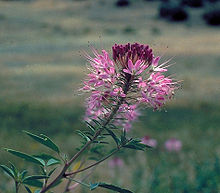- Cleome serrulata
-
Cleome serrulata 
Rocky Mountain Beeweed Scientific classification Kingdom: Plantae (unranked): Angiosperms (unranked): Eudicots (unranked): Rosids Order: Brassicales Family: Cleomaceae Genus: Cleome Species: C. serrulata Binomial name Cleome serrulata
Pursh (1814)Synonyms Peritoma serrulatum DC.
Cleome integrifolia Torr. & GrayCleome serrulata (Rocky Mountain Beeweed, Rocky Mountain Beeplant, Bee Spiderflower, stinking clover, Navajo spinach) is a species of Cleome, native to western North America from southern British Columbia, east to Minnesota and Illinois, and south to New Mexico and northernmost California. It is also naturalized further east in North America. [1][2][3]
Contents
Description
It is an annual plant growing to 10-150 cm (4-60 in) tall, with spirally arranged leaves. The leaves are trifoliate, with three slender leaflets each 1-7 cm (0.4-2.75 in) long. The flowers are reddish-purple, pink, or white, with four petals and six long stamens. The fruit is a capsule 3-6cm (1-2.4 in) long containing several seeds.[1][2]
Taxonomy
In 1817, Frederick Traugott Pursh described this species in the first volume of Flora Americae Septentrionalis.[4]
In the first volume of Prodromus Systematis Naturalis Regni Vegetabilis in 1824 Augustin Pyramus de Candolle moved this species into his idea of what the genus Peritoma should be, calling it Peritoma serrulatum.[5]
In 1901, Edward Lee Greene built a genus of Cleome species based on Candolles Peritoma including this species as Peritoma serrulatum DC. and Peritoma lutem Raf. Other species that were included have since been determined to be synonyms of these species.[6]
- Taxonomy references
-
- Greene, Edward L. (1899-1901). Pittonia A Series of Papers Relating to Botany and Botanists. Volume IV. Washington, D.C.: Press of the Law Reporter Company. http://www.google.com/books?id=QMoWAAAAYAAJ. Retrieved 2009-04-16.
- Candolle, Aug. Pyramo de (1824) (in plantin). Prodromus Systematis Naturalis Regni Vegetabilis: sive enumeratio contracta ordinum generum specierumque plantarum huc usque cognitarum, juxta methodi naturalis normas digesta. Pars Prima. Paris: Sumptibus Treuttel et Würtz. http://books.google.com/books?id=6vQTAAAAQAAJ. Retrieved 2009-04-16.
- Pursh, Fredrick (1814) (in plantin). Flora Americæ Septentrionalis; or, A Systematic Arrangement and Description of the Plants of North America. Containing, besides what have been described by preceding authors, many new and rare species, collected during twelve years travels and residence in that country, in two volumes. Vol. I. London: White, Cochrane, and Co.. http://books.google.com/books?id=12gYAAAAYAAJ. Retrieved 2009-04-16.
Uses
It is used in the southwestern U.S. as a food, medicine, or dye.[7][8] It is called waa’ in the Navajo language. Its scientific description was based on specimens collected on the Lewis and Clark Expedition.[9]
Notes
- ^ a b Plants of British Columbia: Cleome serrulata
- ^ a b Jepson Flora: Cleome serrulata
- ^ USDA Plants Profile: Cleome serrulata
- ^ Flora Americae Septentrionalis (1817), page 441
- ^ Prodromus Systematis (1824), page 237
- ^ Pittonia (1901), page 208
- ^ Northern Arizona University Paleoethnobotany Manual: Bee Weed
- ^ Plants for a Future: Cleome serrulata
- ^ Native Wildflowers of the North Dakota Grasslands: Rocky Mountain Beeplant (Cleome serrulata)
Categories:- Cleomaceae
- Flora of the North-Central United States
- Flora of the Western United States
- Flora of Western Canada
- Flora of California
- Flora of the Rocky Mountains
- Native American cuisine
Wikimedia Foundation. 2010.

